�
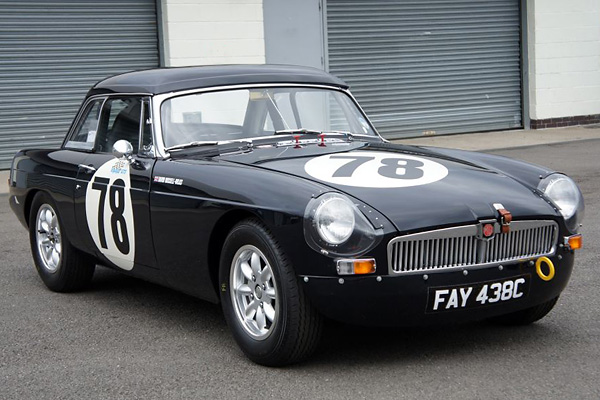
�
(Photo by David Russell-Wilks. Used here by exclusive permission.)
�
David Russell-Wilks' 1965 MGB Vintage Racecar
��
Owner: David Russell-Wilks
�
City: Weston Favell, Northampton, England
�
Model: 1965 MGB
�
Engine: 1950cc four cylinder
�
Race prepared by: owner
�
�
Built on Heritage
��
Back in early 2007, David Russell-Wilks and a colleague were offered a secondhand but never�
built-up Heritage�
bodyshell along with an assorted collection of MGB bits. They quickly began building a racecar.�
David explains: "We made good progress at the start, commencing with the addition of a Custom Cages�
rollcage and dry-fitting of components. We sourced a good engine block, cylinder head, and a�
flat steel crankshaft..." However, the partners began to realize they had different goals and�
expectations for the project. "In June 2009, after I sold my road MGB, it was decided I would�
buy my colleague's half and run the racecar project entirely."�
�
Meanwhile, David had started to work part time at Lone Pine Garage. They're known for�
painting Pebble Beach Concours d'Elegance winning Aston Martins. "I worked for free, hoping�
to gain some experience in order to complete my project. I painted some of the MGB bodyshell at�
home to save money, but I was never all that happy with the finish. Besides, the underside had�
previously been stone-chipped and sealed. I decided to take the plunge and have the bodyshell�
acid dipped and E-coated.¹ The car came back much lighter weight, an ideal starting point�
for building a competitive racecar."�
�
�
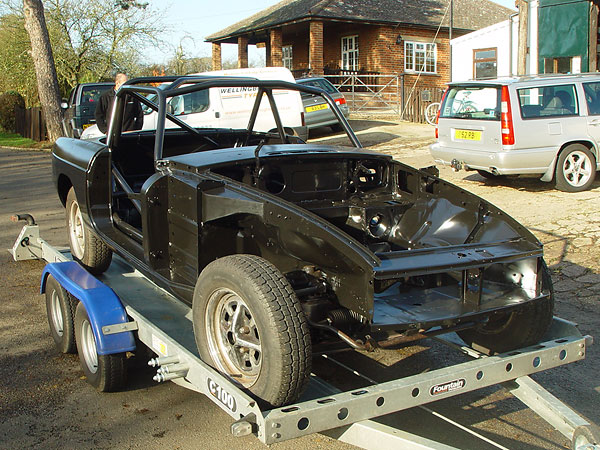
�
David's Heritage MGB upon arrival at Lone Pine Garage in October 2009.
�
(Photo courtesy of David Russell-Wilks. All rights reserved.)
�
�
"In October 2009 I took the car to Lone Pine Garage where I completed the build with�
their guidance and help. Working there allowed me to complete more ambitious modifications.�
For example, we created and installed aluminium door skins and an aluminum rear valance.�
I worked on the car nearly every day. By July 2010, the body work and rolling chassis�
were complete."�
�
David's next step was to turn his attention to the engine. Again, he found a local shop�
with great expertise that he would enjoy working with and learning from. Rob Selby of�
Selby Engineering in Olney, Buckinghamshire specializes in A-Series engines, but has built�
B-Series race engines too. Rob built and balanced David's engine, gas flowed its�
cylinder head, ran the assembled engine in, and fine-tuned the engine on his dyno.�
�
Everything came together in February 2011, and David tested his newly completed racecar at�
Silverstone in March of that year. Since then, David has enjoyed racing his MGB with�
"ecurie GTS", a British racing series for small displacement, pre-1966 FiA-homologated�
production sports cars. Administered by The MG Car Club, ecurie GTS visited six of�
England's best circuits in 2013. David serves on the ecurie GTS Drivers Steering Group.�
�
 �
�
�
�
Features and Specifications
�| Engine: | �BMC B-Series four cylinder engine.�
Bored ~0.106" over to raise displacement from 1798cc to ~1950cc.�
~10.9:1 static compression ratio.�
Steel connecting rods.�
ARP cylinder head studs.�
Aftermarket valve cover, with vent.�
Weber 45 DCOE carburetor.�
TWM Induction 9.5cm intake manifold.�
Lucas distributor.�
Pertronix Ignitor breakerless ignition trigger.�
Pertronix ignition coil.�
Magnecor Electrosports 80 spark plug wires.�
NGK B8EGV spark plugs.�
K&N HP-2004 oil filter.�
Baffled deep sump oil pan.�
Alloy Racing Fabrications crankcase breather tank.�
Alloy Racing Fabrications aluminum fuel cell.�
Facet Bendix-style fuel pump.�
| �
| Cooling: | �stock MGB copper-and-brass radiator.�
Samco "Classic Silicone" hoses.�
Stock MGB oil cooler.�
No cooling fan. | �
| Exhaust: | �Tourist Trophy all stainless steel system�
(featuring three-into-one header and single muffler). | �
| Transmission: | �Hardy Engineering straight cut, close ratio gear set (1st 3.64:1, 2nd 1.62:1, 3rd 1.27:1 and 4th 1:1.)�
Fiberglass gear selector cover.�
Helix Autosport 8.5" organic clutch. | �
| Rear Axle: | �original banjo-style housing.�
4.1:1 rear axle ratio.�
Limited slip differential. | �
| Front Susp.: | �Moss 660lb/in front springs.�
Rebuilt lever shock absorbers.�
SuperFlex polyurethane wishbone bushes.�
Moss 7/8" anti-sway bar, mounted on aluminum pillow blocks.�
Moss quick ratio steering rack. | �
| Rear Susp.: | �Moss parabolic two-leaf 100#/inch leaf springs (de-arched to give a suitable ride height.)�
Adjustable lever shock absorbers. | �
| Brakes: | �(master) single circuit master cylinder. � (front) stock rotors and calipers. Mintex pads. � (rear) stock drum brakes. | �
| Wheels/Tires: | �eight spoke (Minilite replica) 5.5J-14 aluminum wheels.�
Dunlop Racing CR65 204 Mark II (5.50L-14) tires. | �
| Body: | �Heritage bodyshell.�
Aluminum front valance (standard 10.5" height.)�
Aluminum bonnet.�
Leather bonnet tie-down strap.�
Sebring style Perspex headlamp covers.�
Cibie H4 halogen headlamps.�
Aluminum door skins.�
Drilled door hinges and boot lid hinges.�
Aluminum battery box cover. | �
| Safety Eqmt: | �Custom Cages welded-in roll cage.�
OMP Ecolife AFFF centralized fire suppression system.�
Ridgard RS9 steel-frame drivers seat, mounted on OMP aluminum brackets.�
Willans safety harness.�
Moto-Lita leather wrapped steering wheel. | �
| Instruments: | �Smiths dual oil pressure (0-100psi) and water temperature (30-110C) gauge,�
Smiths speedometer (0-120mph),�
Smiths tachometer (0-8000rpm), and�
Smiths oil temperature (40-140C) gauge.�
Farringdon Instruments FD20 data logger, mounted in glove box.�
Farringdon Instruments RCA60 lap timer display, mounted to radio blanking plate.�
Speed Systems programmable shift light. | �
| Electrical: | �Lucas alternator, with oversized aluminum pulley.�
Single Lucas 12V lead acid battery (size L002, weighs 10kgs.)�
Moss gear reduction starter. | �
| Weight: | �838kg (1847#) without fuel. | �
| Comments: | �races in ecurie GTS class 4 (for cars up to 2000cc). | �
Engine Installation
��
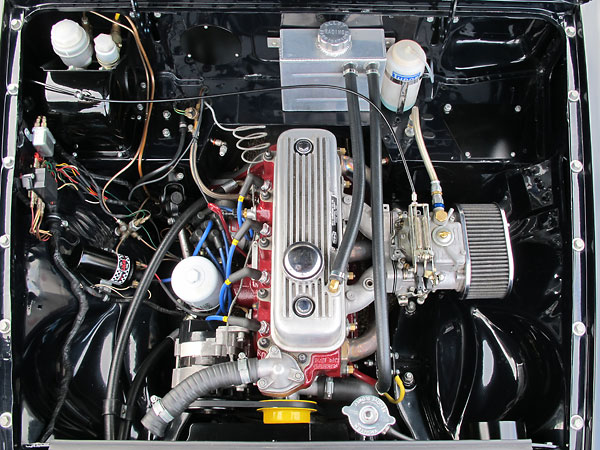
�
Rob Selby of Selby Engineering built and balanced David's engine.
�
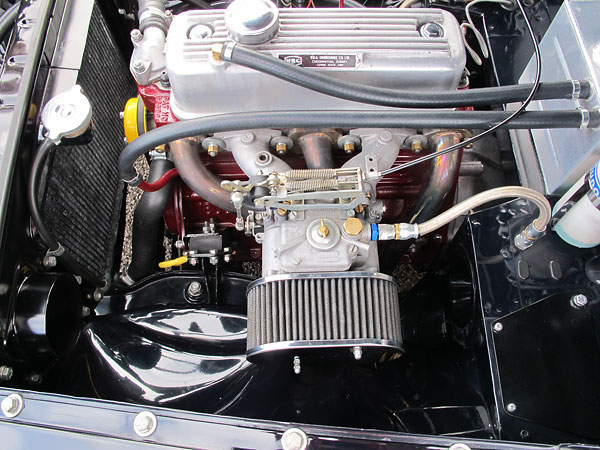
�
Weber 45 DCOE carburetor. TWM Induction 9.5cm intake manifold.
�
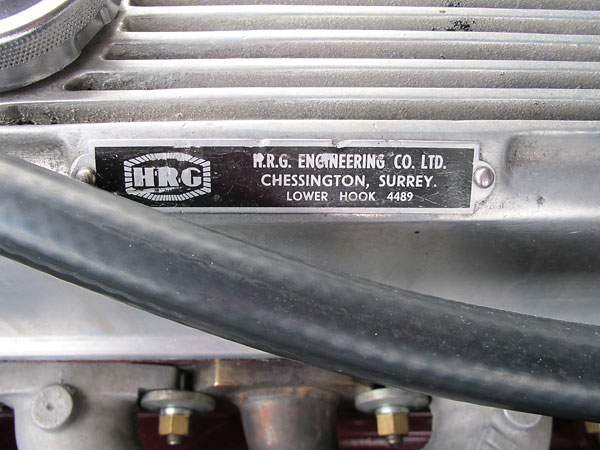
�
H.R.G. Engineering Co. Ltd., Chessington Surrey, Lower Hook, 4489
�
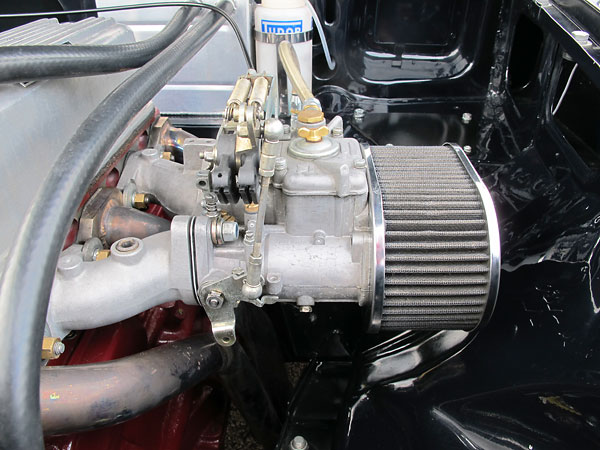
�
The fuel system pressure runs about 4psi without any regulator installed.
�
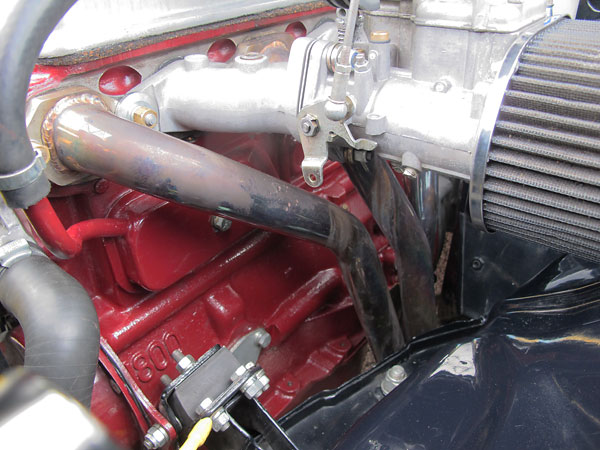
�
This three-into-one header is part of a Tourist Trophy stainless steel exhaust system.
�
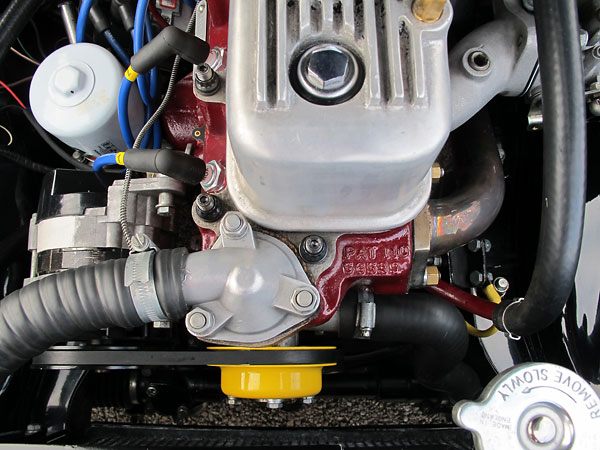
�
Samco "Classic Silicone" hoses. ARP cylinder head studs.
�
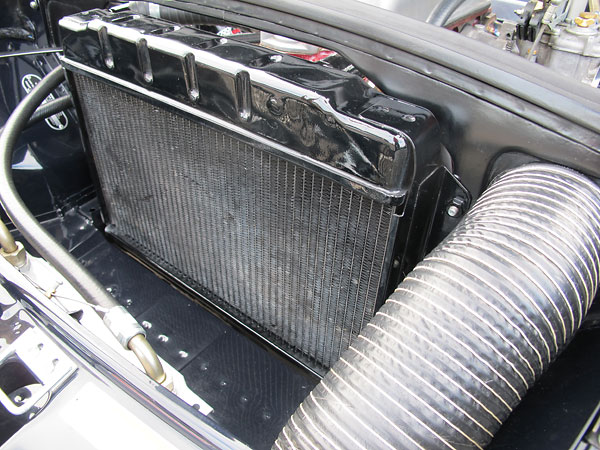
�
Stock MGB copper-and-brass radiator.
�
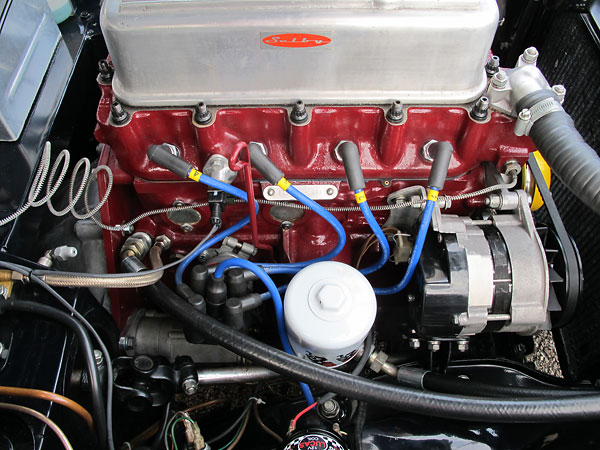
�
A Pertronix Ignitor electronic ignition module has been installed inside the Lucas distributor in lieu
�
of traditional breaker points and condenser. It uses a Hall effect sensor to detect the passing
�
of tiny magnets. This solution is more precise and also less sensitive to mechanical wear.
�
(Note: Lumenition's equivalent is called "Magnetronic". Don't confuse it with Lumenition's
�
"Optronic" system which utilizes an optical sensor and an externally mounted amplifier.)
�
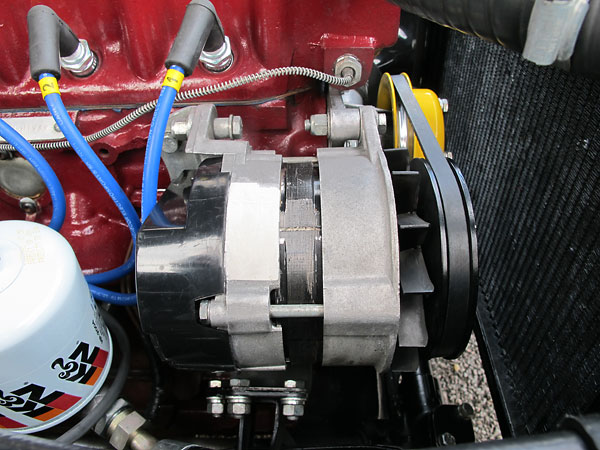
�
This Lucas alternator has been fitted with an oversize aluminum pulley to make it spin
�
a little slower than usual. (Note: MG upgraded from generators to alternators in 1968.)
�
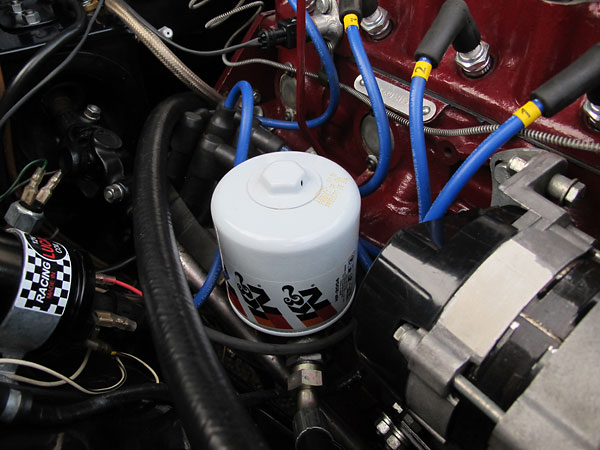
�
K&N HP-2004 engine oil filter, inverted. (MG used inverted spin-on filters from March 1970 through
�
November 1973 and again from 1976 through 1980. Early MGBs used canister oil filters.
�
1974 and 1975 MGBs used hanging spin-on filters.)
�
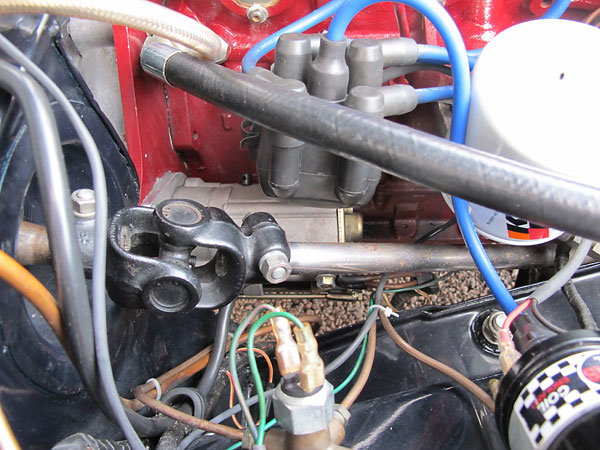
�
A modern gear reduction starter is lighter than stock and also turns the engine over faster.
�
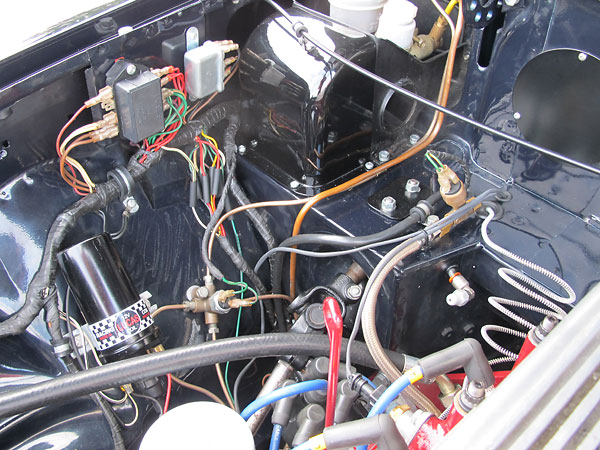
�
Pertronix ignition coil. (A Lucas decal on the bracket lends a period look.)
�
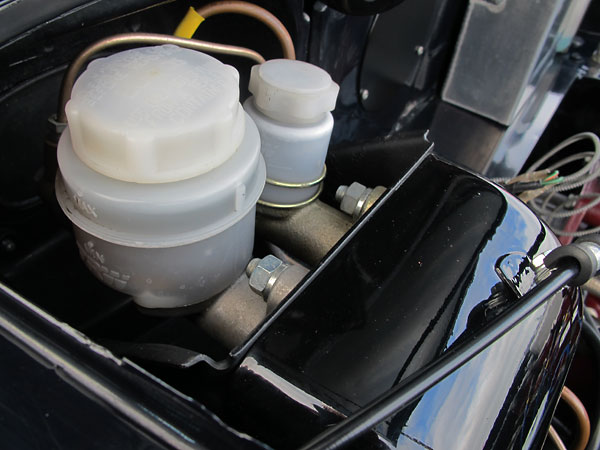
�
Transparent nylon reservoirs make it easy to verify fluid level. Both of these master cylinders
�
(brake and clutch) are aftermarket designs specifically made for MGB. Factory-installed single
�
circuit brake master cylinders - and clutch master cylinders - had fabricated steel housings.
�
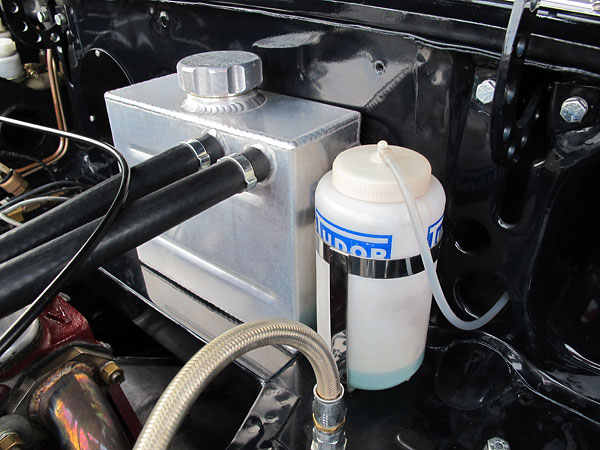
�
Alloy Racing Fabrications crankcase breather tank.
�
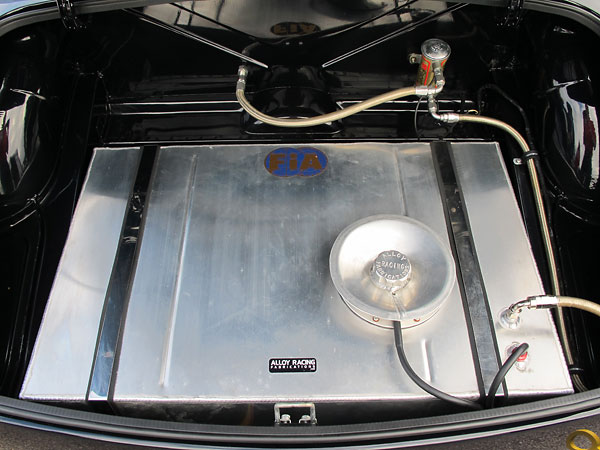
�
Alloy Racing Fabrications aluminum fuel cell.
�
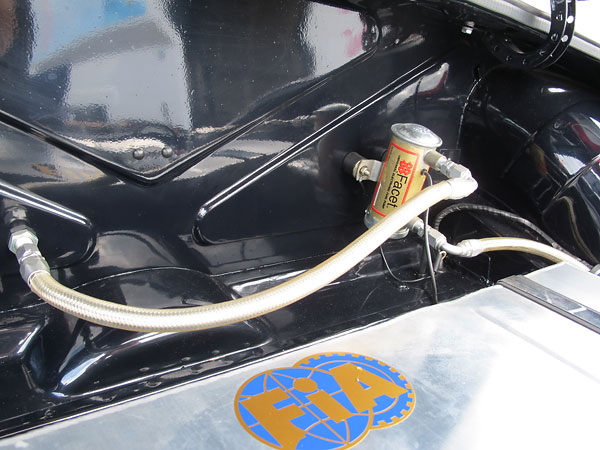
�
Facet Bendix-style electric fuel pump.
�
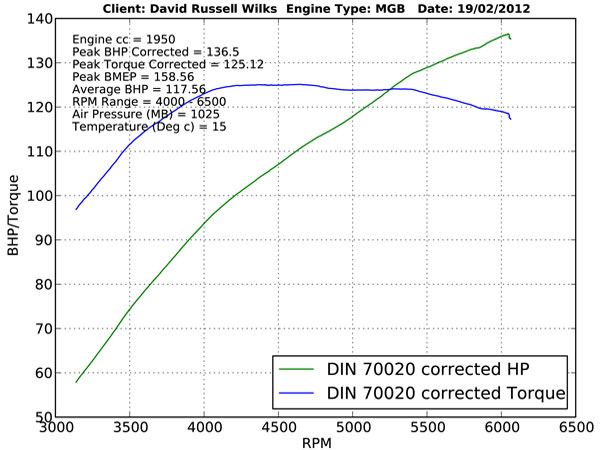
�
�
�
Haven't You Been Mooching Long Enough?
�
The least you could do is toss some change in our tip jar. Give as little or as much as you like.
�
Right now is the right time. Your donation will help keep BritishRacecar alive and growing.
�
Simply click here and follow the instructions.
�
Front Suspension
��
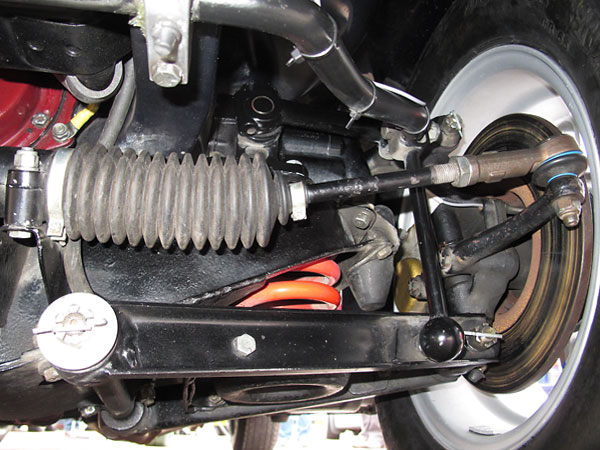
�
Moss 660lb/in front springs give a ride height of ~12.5" at the front. "I have been meaning
�
to experiment with a set of 800lb springs from MG Motorsport, but found the handling quite
�
acceptable as is." The car has not been corner-weighted, but it will be for 2014.
�
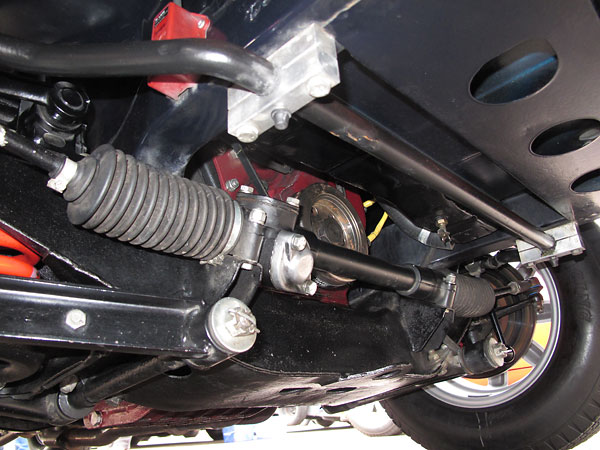
�
Moss 7/8" anti-sway bar, mounted on aluminum pillow blocks.
�

�
Unmodified front crossmember. Moss quick ratio steering rack. Aluminum front pulley.
�
Please support the sponsoring companies who make www.BritishRaceCar.com possible, including:
� �
 �
�
�
�
Rear Suspension
��
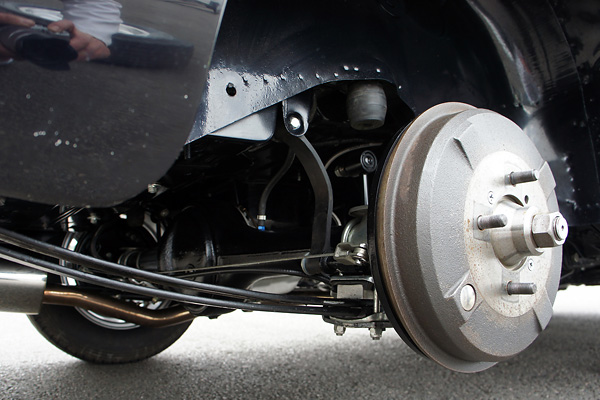
�
Parabolic two-leaf 100#/inch leaf springs. "When originally fitted they made the rear end of the
�
car very high, so I had them recurved to give a ride height of 10.5 inches. At the moment,
�
they are in their lowest position. This can be adjusted with aluminium shims."
�
(Photo courtesy of David Russell-Wilks. All rights reserved.)
�
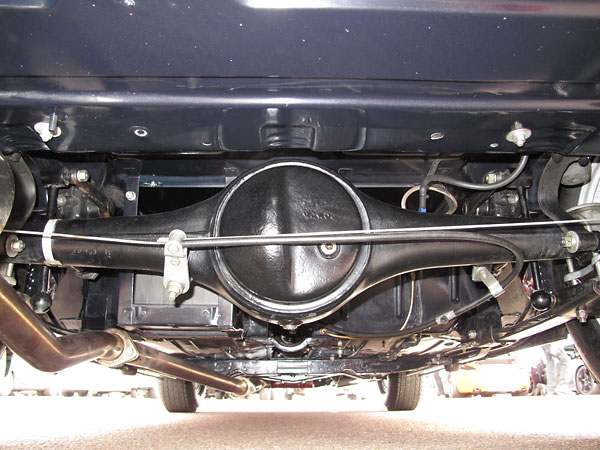
�
David uses a 4.1:1 gear set for all races. "Some people use 4.3:1, but this can be a
�
bit short for the longer circuits like Silverstone and Snetterton."
�
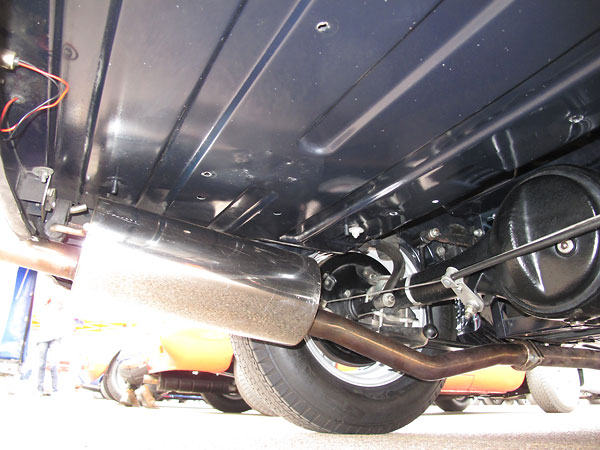
�
This Tourist Trophy stainless steel muffler helps David comply with noise restrictions.
�
Usually the limit for U.K. races is 105dB, and the limit for European races is 99dB.
�
�
Interior
��
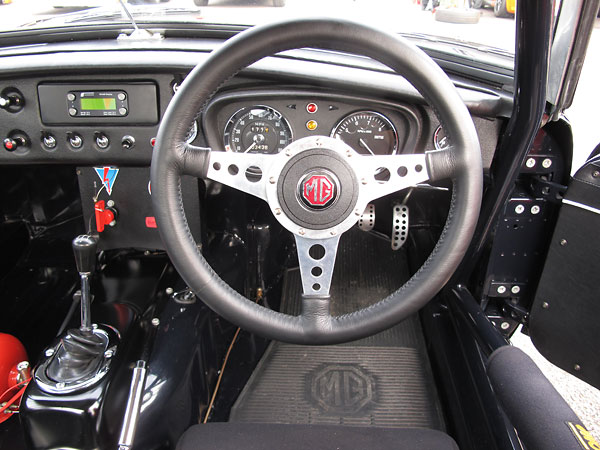
�
A Farringdon Instruments RCA60 LCD display is mounted in the radio blanking plate.
�
Its the driver interface for a lap timer and data acquisition system. (More info below.)
�
Four numbered buttons on its face toggle various functions and settings. The small
�
print says: "Set Up 1 & 2. Recall 3 & 4. Clear Laps 1 & 4. Clear Time 2 & 3."
�
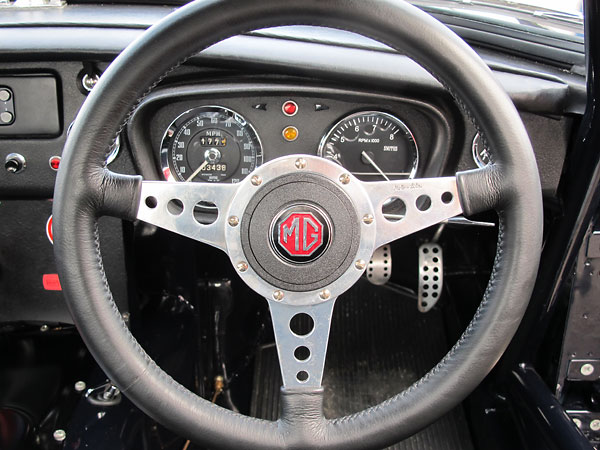
�
Moto-Lita leather wrapped steering wheel.
�
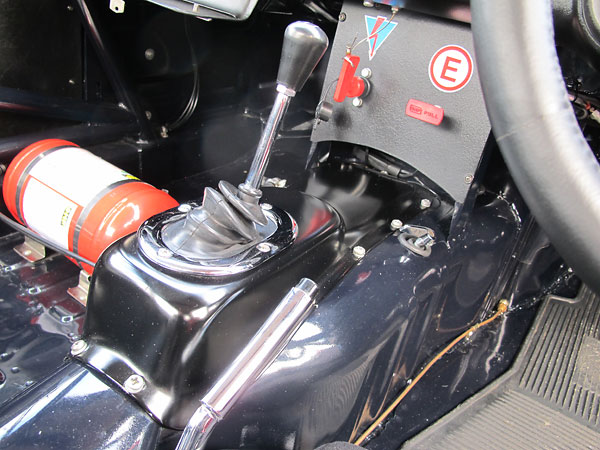
�
This aftermarket gear selector cover from Clark & Clark is fiberglass instead of steel. To the
�
right and forward of the shifter, a reverse lockout pin replaces one of the detent springs
�
in the gearbox to prevent the driver from shifting into reverse gear by mistake.
�
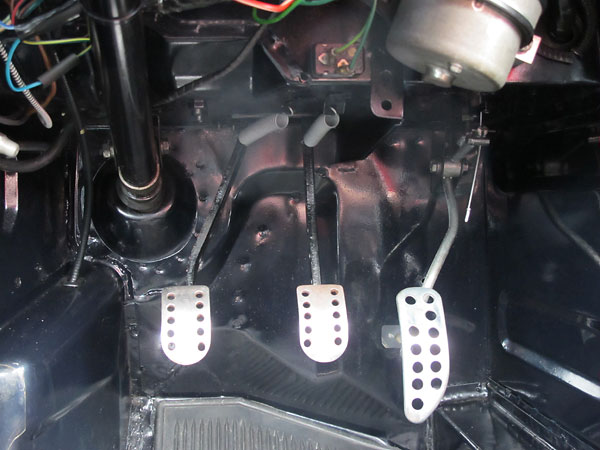
�
Rubber floormats are ONLY in place when David's car is in the paddock or at home in the
�
garage. They protect paint, but while racing they could slide around and impair David's driving.
�
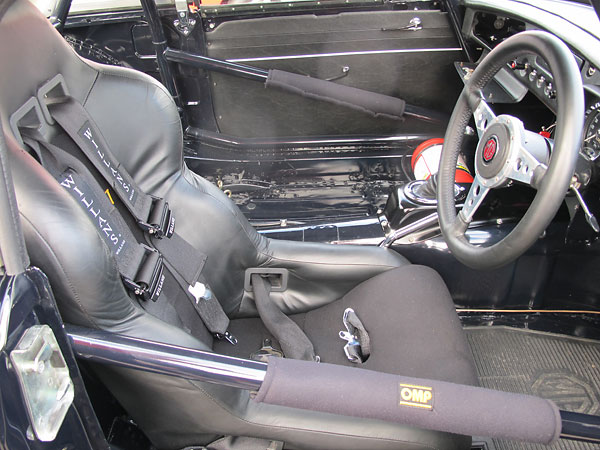
�
This is a robust rollcage with extra tubes across the door sills and behind the dashboard.
�
While showing it to me, David observed that U.K. rulemakers once seemed to prefer bolt-in
�
door bars but now they prefer welded-in bars. Possibly they believed bolt-in bars would
�
facilitate extraction of drivers after accidents. Welded-in bars are appreciably stronger
�
in most instances. David paid: £700 for cage material plus £700 for fabrication labour.
�
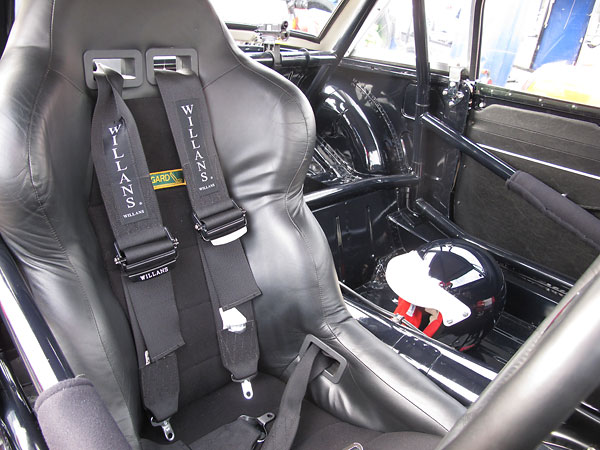
�
This model of Ridgard seat has a steel frame. Its production date isn't labeled, so it
�
doesn't meet FiA rules for racing on the European mainland but it's acceptable for racing in
�
England and its label will never expire. The Willans safety harness is date coded, of course.
�
�
Seriously, for the cost of a beer you can make a real difference.
�
Your donation will help keep the BritishRacecar staff motivated to publish more.
�
Larger donations will tangibly help us travel to races, maintain camera equipment, etc.
�
Simply click here and follow the instructions.
�
�
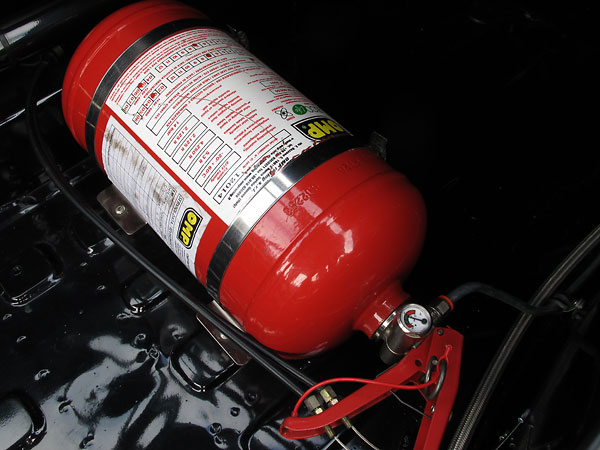
�
This OMP Ecolife AFFF centralized fire suppression system has a 5.3L bottle, which is
�
rather large for an MGB. For 2014, David plans to install a smaller fire extinguisher
�
(and also a lighter weight battery) to approach the 830kg weight limit for his class.
�
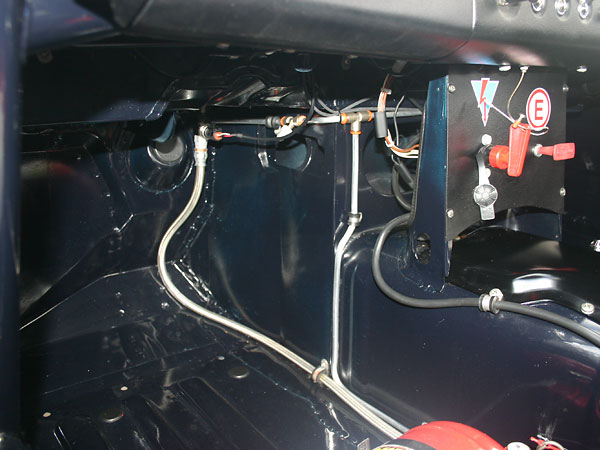
�
This MGB features the narrow ("three synchro") transmission tunnel which is characteristic
�
of Mk1 cars. Press tooling for the narrow tunnels was destroyed decades ago, after MG
�
transitioned to a larger tunnel to suit a larger gearbox. This tunnel was cut from a donor
�
car and provided to British Motor Heritage; then they built a new bodyshell around it.
�
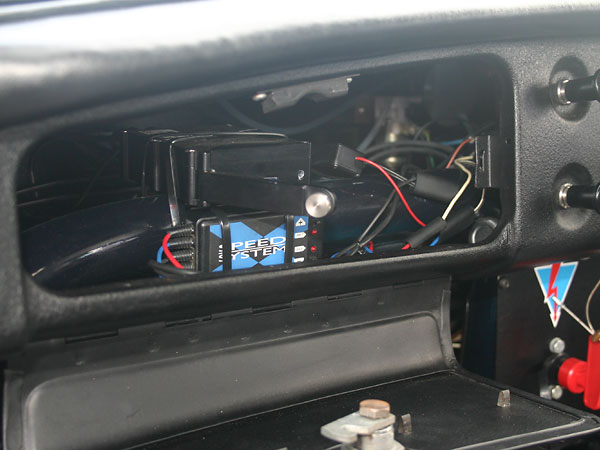
�
The rollcage features a robust behind-the-dashboard crossbrace. A Farringdon Instruments
�
FD20 data logger is tie-wrapped atop the tube. We can also see a Speed Systems soft cut
�
rev-limiter, which David has programmed to come in around 6,800rpm. The Speed Systems
�
device includes a programmable shift light feature too.
�
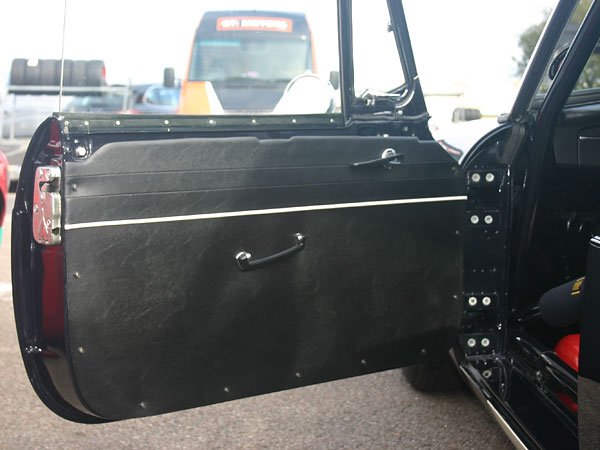
�
Nicely upholstered door card. This MGB is competitive in its class, but it remains street legal.
�
David tries to keep it reasonably drivable too. Example: rather than a racing clutch, he uses
�
a Helix Autosport 8.5" organic clutch. It's proven robust enough for two racing seasons.
�
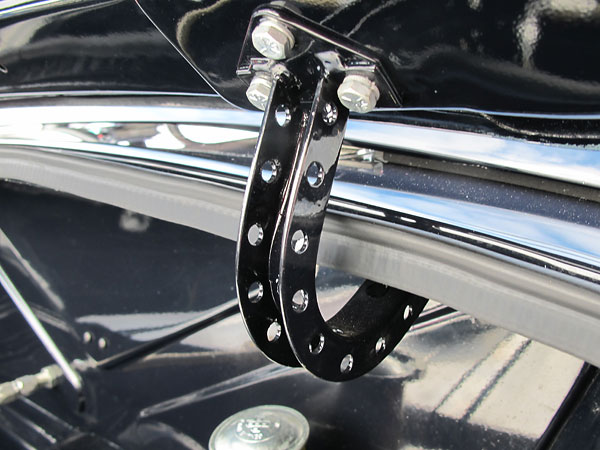
�
David was working at Lone Pine Garage in Olney when he started building this racecar.
�
During tea breaks David used their shop equipment to shave grams here and there.
�
�
Exterior
��
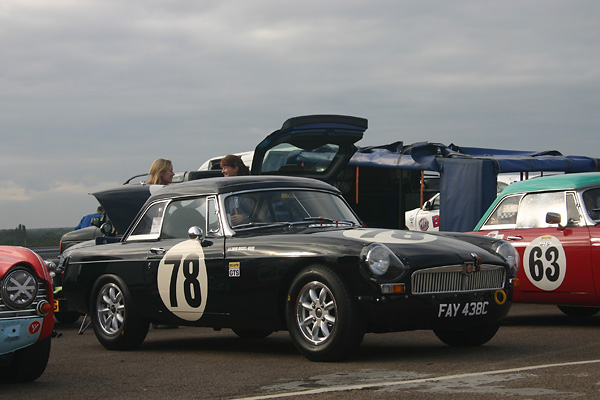
�
Opened in 1951, Snetterton is one of several venerable racetracks built on WWII bomber bases.
�
During the war, the base was principally used by United States B17s. It's located 18 miles south-west
�
of Norwich. From 1956, it was the home of the Jim Russell Driving School. In the late sixties and
�
early seventies, Snetterton was the home track of Team Lotus. From 1973 to 2002, Snetterton was
�
the home of Van Dieman International, Ltd., a leading manufacturer of Formula Ford racecars.
�
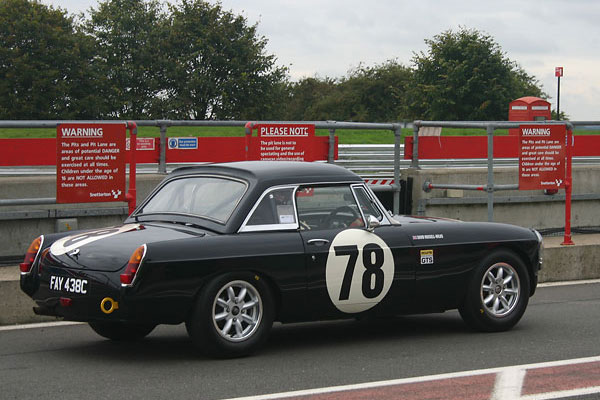
�
We enjoyed watching David contest an ecurie GTS series race at Snetterton in October 2013.
�
Based on Saturday's Qualifying Race results, David started seventh of thirteen cars in
�
Sunday's race and advanced to finish fifth overall with a best lap time of 1:33.454,
�
averaging 74.43mph around the challenging 1.9840 mile circuit.
�
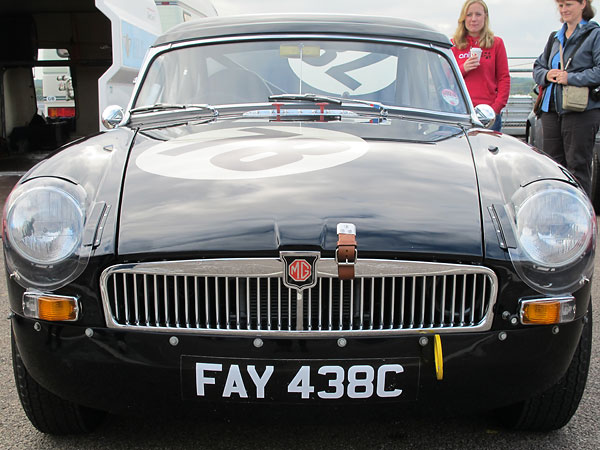
�
ecurie GTS is a British racing series for small displacement pre-1966 FiA homologated production
�
sports cars. Administered by The MG Car Club, ecurie GTS visited six of England's best circuits
�
in 2013. ecurie GTS rules mirror FiA's Appendix K, with just a few pragmatic exceptions.
�
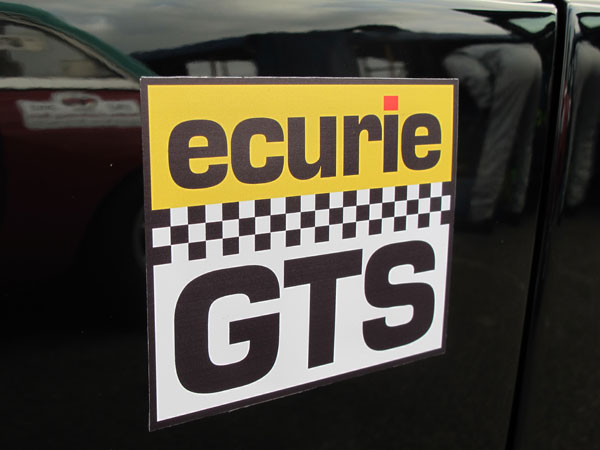
�
Nineteen makes of classic sportscars are eligible to compete in ecurie GTS events. They're
�
divided into five classes by displacement. Group 4 is by far the most populous. MGB, Elva
�
Courier, and TVR Grantura race there. At Snetterton, two Triumph TR4s contested Group 5.
�
�
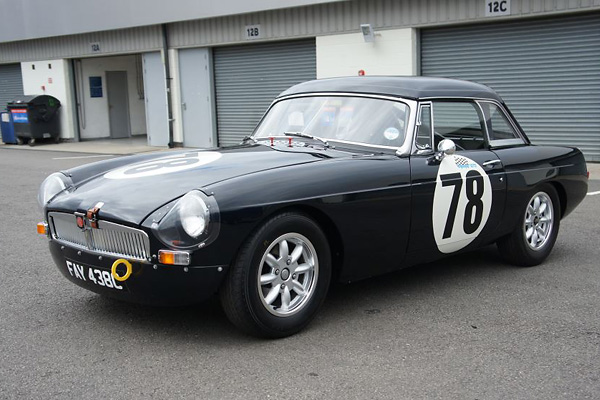
�
One of the easiest ways to speed up an MGB is to reduce airflow underneath the car with
�
a spoiler or air dam, but they're prohibited by ecurie GTS. In fact, deep section
�
front valances have now been prohibited too. Valances must have a crease to retain
�
original MGB styling. Valance material may be steel, aluminum, or fiberglass.
�
Holes for an oil cooler are allowed, but brake cooling ducts are prohibited.
�
(Photo by David Russell-Wilks. Used here by exclusive permission.)
�
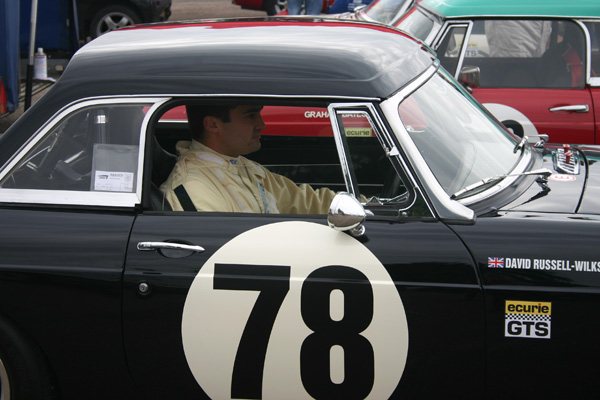
�
For MGBs, the rulebook says: "All cars must run with closed cockpits using an original
�
factory hardtop." Hardtops were prevalent on MGBs raced in England in the early sixties,
�
and were also fitted to the works team MGBs, but the main rationale for the rule is
�
probably that hardtops hide modern safety equipment: rollcages, tall racing seats, etc.�
�
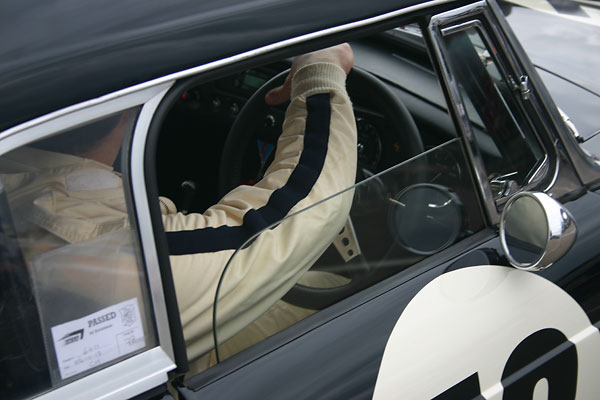
�
This "Midnight Blue" is a 1965 BMC color, although not offered on MGBs that year.
�
It's very dark! My photos don't do it justice; this car is stunning in person.
�
David gives Lone Pine Garage the credit for his car's excellent paint job.
�
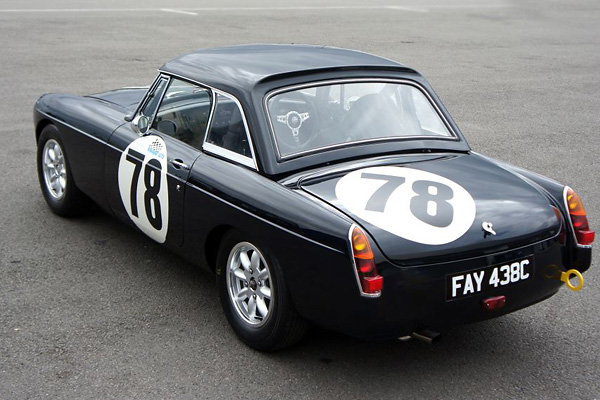
�
Rain light from a 1960s motorbike, installed upside down to also serve as a license plate lamp.
�
(Photo by David Russell-Wilks. Used here by exclusive permission.)
�
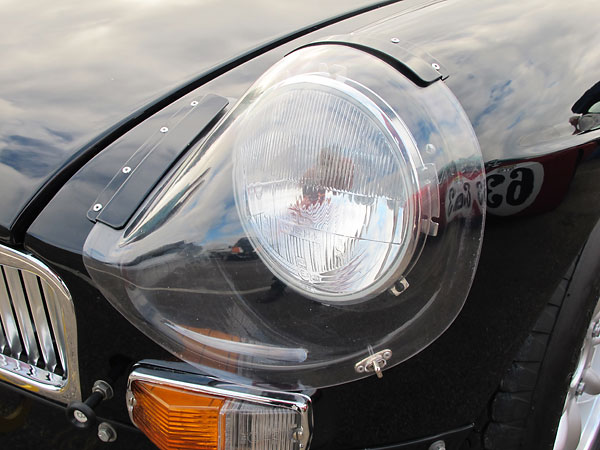
�
Sebring style headlight fairing. Cibie H4 halogen headlamp.
�
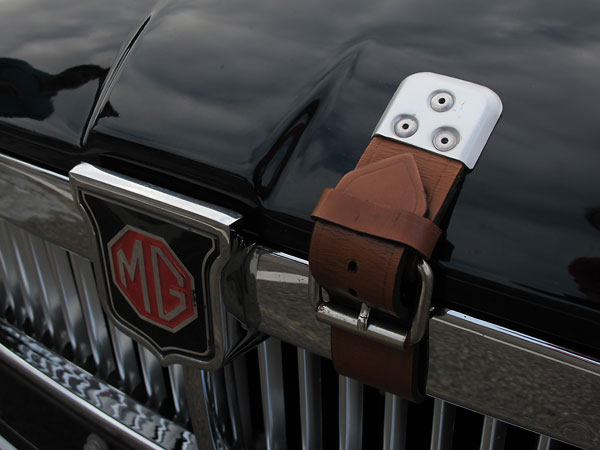
�
Leather bonnet hold-down strap.
�
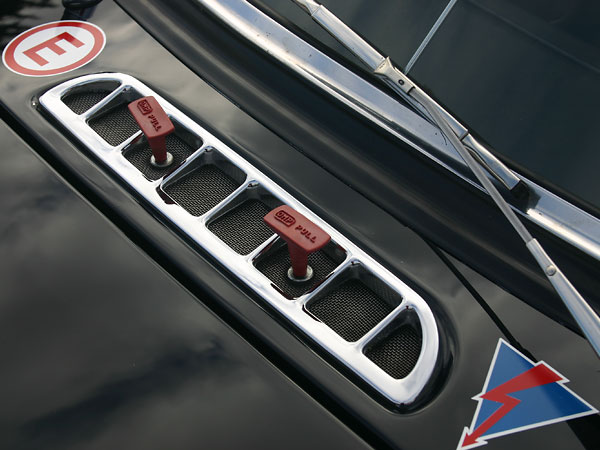
�
Stickers: "E" for extinguisher and "spark" logo for the master cut-off switch. FiA spec
�
cut-off switches turn off the engine's ignition system and also disconnect the battery.
�
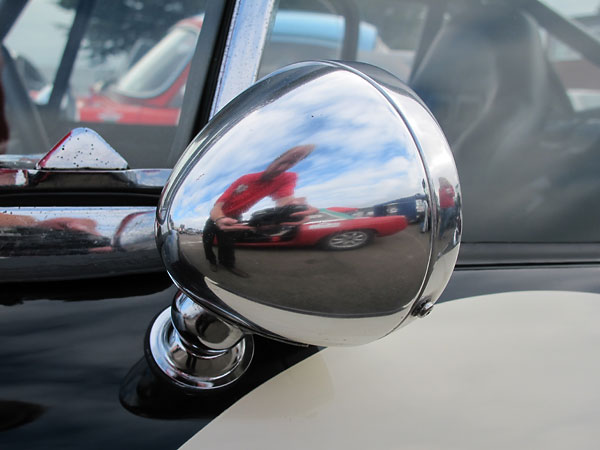
�
Raydot replica side view mirror: "I changed to a convex mirror to see a bit more.
�
The driver's side is okay, but I struggle to see anything from the passenger side."
�
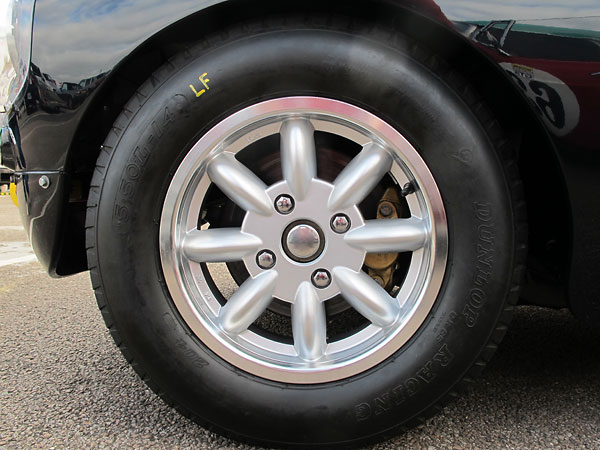
�
Ecurie GTS rules for wheel and tire selection are rather specific. Wheels must be the
�
exact size originally fitted by the OEM, and must retain a period-correct appearance.
�
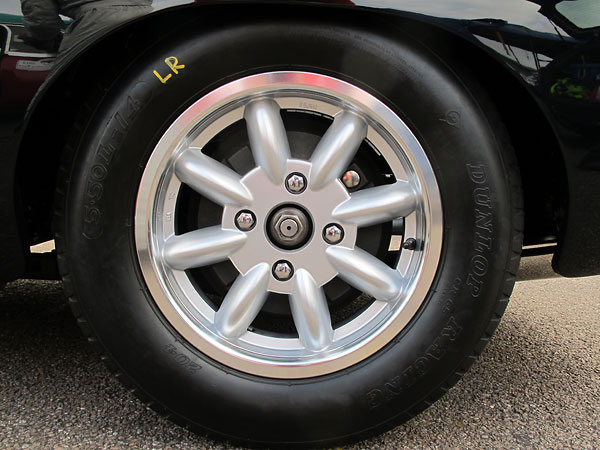
�
For 2013, ecurie GTS mandated use of Dunlop Racing's CR65 tires and racers were
�
allowed to select between L and M section widths. However, the M's won't fit a
�
standard MGB without rolled wheel arches so pretty much everyone uses L's.
�
| Notes: | ||
| (1) | �
The most obvious selling points of Heritage bodyshells are that they don't come with�
corrosion or collision damage and they don't come with significant metal fatigue either.�
Less obvious advantages include: (1) they're built with better quality steel than MG�
had access to, and (2) they're treated to provide categorically superior corrosion�
resistance and paint adhesion. E-coat is a subclass of electrophoretic deposition painting;�
it's a technology by which very high quality epoxy primer is electrically bonded to�
every surface of car bodies via immersion in a chemical bath. (The primer is then oven�
cured.) E-coat is used by every modern automotive manufacturer worldwide. British Motor�
Heritage has E-coated Heritage bodyshells since their production commenced in 1988.�
For additional corrosion protection, in 1993 British Motor Heritage began using�
galvannealed (not galvanized) zinc-coated steel sheet. �
� Disillusioned after his first attempt at painting and unhappy about previously applied undercoatings, � David took his bodyshell to Surface Processing Ltd. in the West Midlands. SPL's stripping� process starts out with "advanced dehydration". By that, we think they mainly� mean "heat". Their second stage is an alkaline bath, which removes any organic contaminants� such as grease, oil, and most old paint including the E-coat primer described above.� Stage three is the famous "acid dip". A dilute solution of inhibited hydrochloric acid� will remove rust and any remaining traces of coatings. Depending on concentration and cycle� time, the acid may thin and lighten the steel bodyshell somewhat. SPL's fourth stage is an� "agitated alkaline neutralisation and passivation immersion" rinse. Finally, they complete� their work with an eleven stage E-coat treatment that includes a Zn/Mn/Ni phosphate layer� before deposition of PPG electrophoretic epoxy primer. � � | |
�
| �
� 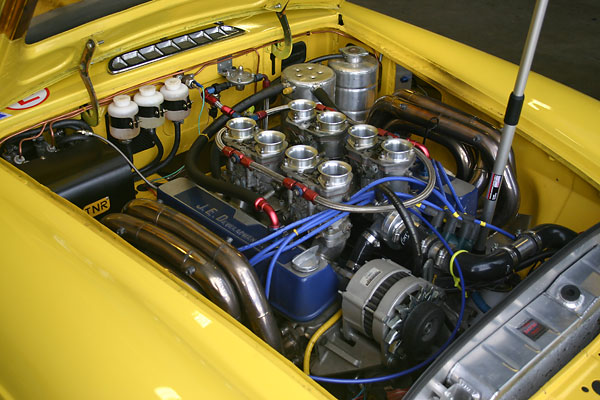 � Ollie Neaves' MGB GT V8 Racecar, as photographed by Curtis Jacobson for BritishRacecar.com � Did you enjoy and learn from this article? We have over 10,000 more racecar photos to � publish. But first, we need more readers to pitch-in and help cover this website's � expenses. Please consider making a contribution today. Any amount is helpful. � (A complete list of previous contributors may be found here.) � � |
�
Except for four photos explicitly credited to David in their captions above, �
the photos in this article are from October 2013 when we viewed David's MGB at�
The MG Car Club's Autumn Race Meeting at Snetterton, near Norwich England.�
Photos by Curtis Jacobson for BritishRaceCar.com, copyright 2013. All rights reserved.
�
| If you liked this article, you'll probably also enjoy these: | �|||||
 | �
David Child 1964 MG MGB | �
 | �
John Targett 1964 MG MGB | �
 | �
Shaun Holmes 1969 MGC GT | �
| You're invited to discuss anything you've seen here on The British Racecar Motorsports Forum! | �|||||
�
Notice: all the articles and almost all the photos on BritishRacecar.com are by Curtis Jacobson.
�
(Photos that aren't by Curtis are explicitly credited.) Reproduction without prior written permission is prohibited.
�
Contact us to purchase images or reproduction permission. Higher resolution images are optionally available.
�

 �
�
